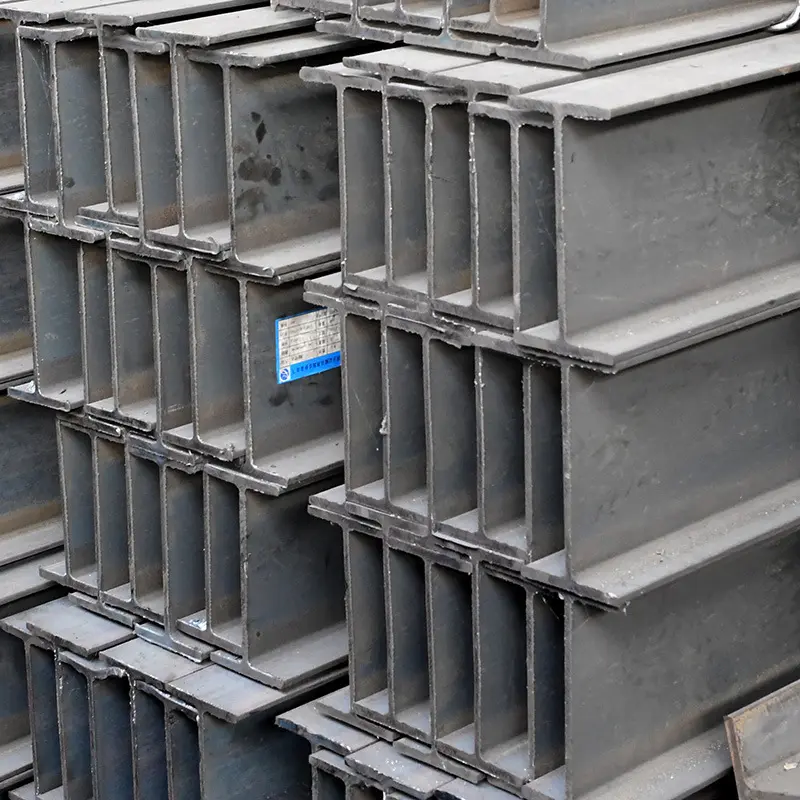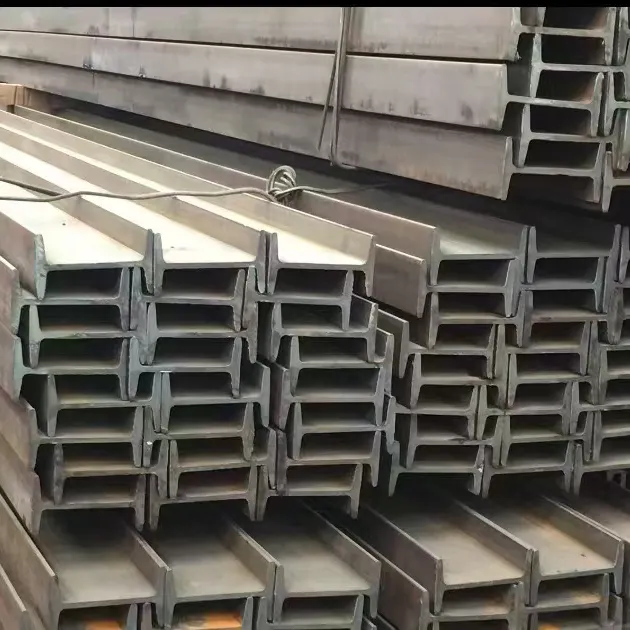Let us explain the characteristics and application scope of H-beam
H-beam is an economical and efficient profile with a more optimized cross-sectional area distribution and a more reasonable strength to weight ratio, named after its cross-section that is the same as the English letter "H".
Due to the right angle arrangement of various parts of H-beams, they have the advantages of strong bending resistance, simple construction, cost savings, and lightweight structure in all directions, and have been widely used.


1、 Scope of application of H-beam
(1)、H-shaped steel is mainly used for beam and column components in industrial and civil structures.
(2)、Steel structure load-bearing brackets for industrial structures
(3)、Steel piles and supporting structures for underground engineering
(4)、Equipment structure for petrochemical and power industries
(5)、Large span steel bridge components
(6)、Ship and machinery manufacturing frame structure
(7)、Train, car, tractor beam bracket
Port conveyor belt, high-speed barrier bracket
H-beam is an economical cross-sectional steel widely used in industries, construction, bridges, oil drilling platforms, and other fields
2、 Introduction to H-shaped Steel Classification
H-beamsare divided into two types: hot-rolled H-beams and welded H-beams (H). Hot Rolled H-beams are further divided into three types: wide flange H-beams (HW), medium flange H-beams (HM), and narrow flange H-beams (HN)..
HW is an H-beam with a height and flange width that are essentially equal; Mainly used for Steel Core columns in reinforced concrete frame structures, also known as stiff steel columns; Mainly used for columns in steel structures
HM is an H-beam with a height to flange width ratio of approximately 1.33 to 1.75, mainly used in steel structures as steel frame columns and frame beams in frame structures subjected to dynamic loads; For example: device platform
HN is an H-beam with a height to flange width ratio greater than or equal to 2, mainly used for beams; The use of I-beams is equivalent to HN section steel;
The main materials of H-beam include Q235B, SM490, SS400, Q345, Q345B, etc
H-beam is a new type of economic building steel. H-shaped steel has an economical and reasonable cross-sectional shape, good mechanical properties, and uniform extension at various points on the cross-section during rolling, with low internal stress. Compared with ordinary I-beams, it has the advantages of large cross-sectional modulus, light weight, and metal saving, which can reduce the weight of building structures by 30-40%; Due to the parallel inner and outer sides of its legs and the right angle of its leg ends, it can be assembled into a component, saving up to 25% of welding and riveting work. Commonly used for large buildings that require high load-bearing capacity and good cross-sectional stability (such as factories, high-rise buildings, etc.), as well as bridges, ships, lifting and transportation machinery, equipment foundations, brackets, foundation piles, etc.
H-beam is an economical section steel with superior mechanical properties, developed through the optimization of I-beam, especially named after its section that is identical to the English letter "H". Its characteristics are as follows:
Wide wing edge and high lateral stiffness. Strong bending resistance, about 5% -10% higher than I-beam.
The two surfaces of the wing edge are parallel to each other, making it easy to connect, process, and install.
Compared with welded I-beams, it has low cost, high precision, low residual stress, and does not require expensive welding materials and weld seam testing, saving about 30% of steel structure production costs.
Under the same cross-sectional load, hot-rolled H-beam structures reduce weight by 15% -20% compared to traditional steel structures.
Compared with concrete structures, hot-rolled H-beam structures can increase the usable area by 6%, reduce the self weight of the structure by 20% to 30%, and decrease the internal forces in structural design.
H-shaped steel can be processed into T-shaped steel, and honeycomb beams can be combined to form various cross-sectional forms, greatly meeting the needs of engineering design and production.
H-beams belong to efficient and economical cutting profiles (other types include cold-formed thin-walled steel, profiled steel plates, etc.). Due to their reasonable cross-sectional shape, they can enable steel to exert higher efficiency and improve load-bearing capacity. Unlike ordinary I-beams, the flange of H-beams has been widened, and the inner and outer surfaces are usually parallel, making it easier to connect with high-strength bolts and other components. Its size composition series is reasonable, the models are complete, and it is easy to design and select. The flanges of the 03 H-beam are of equal thickness, with rolled sections and composite sections composed of three welded plates. I-beams are all rolled sections, and due to poor production processes, there is a 1:10 slope on the inner edge of the flange. The rolling of H-beams is different from that of ordinary I-beams, which only use one set of horizontal rollers. Due to its wide flange and no slope (or very small slope), a set of vertical rollers must be added for simultaneous rolling. Therefore, its rolling process and equipment are more complex than ordinary rolling mills. The maximum height of rolled H-beams that can be produced domestically is 800mm, which exceeds the requirement for welded composite sections. The national standard for hot-rolled H-beams in China (GB/T11263-1998) divides H-beams into three categories: narrow flange, wide flange, and steel piles, with codes hz, hk, and hu respectively. Narrow flange H-beams are suitable for beams or compression bending members, while wide flange H-beams and H-beams are suitable for axial compression members or compression bending members. Compared with H-beams, I-beams are inferior in weight to H-beams in terms of w, ix, and iy.
Analysis of Characteristics of Section Steel
1.High structural strength: Compared with I-beams, the section modulus is larger, which can save 10-15% of metal under the same bearing conditions.
2.Flexible and rich design style: With the same beam height, the spacing of steel structures can be 50% larger than that of concrete structures, making the building layout more flexible.
3.Light self weight of the structure: Compared with the self weight of concrete structures, the reduction of self weight of the structure reduces the internal forces in the structural design, which can make the foundation treatment requirements of the building structure low, the construction simple, and the cost reduced.
4.High structural stability: Steel structures mainly made of hot-rolled H-beams have a scientific and reasonable structure, good plasticity and flexibility, high structural stability, and are suitable for building structures that can withstand large vibration and impact loads. They have strong resistance to natural disasters and are particularly suitable for building structures in earthquake prone zones. According to statistics, among the catastrophic earthquakes of magnitude 7 or above in the world, steel structures mainly made of H-beams suffer the least damage.
5.Increasing the effective usable area of the structure: Compared with concrete structures, steel structure columns have a smaller cross-sectional area, which can increase the effective usable area of the building. Depending on the different forms of the building, it can increase the effective usable area by 4-6%.
6.Save labor and materials: Compared with welded H-beams, it can significantly save labor and materials, reduce the consumption of raw materials, energy, and labor, have low residual stress, and have good appearance and surface quality.
7.Easy to machine: Easy to connect and install structurally, and also easy to dismantle and reuse.
8.Environmental Protection: The use of H-beams can effectively protect the environment, which is manifested in three aspects: firstly, compared with concrete, dry construction can be used, which produces less noise and dust; Secondly, due to the reduction of self weight, the amount of soil taken for foundation construction is small, resulting in minimal damage to land resources. In addition, the amount of concrete used is greatly reduced, and the amount of mountain excavation is reduced, which is beneficial for the protection of the ecological environment; Thirdly, after the service life of the building structure expires and the structure is demolished, the amount of solid waste generated is small, and the recycling value of scrap steel resources is high.
9.High degree of industrial production: Steel structures mainly made of hot-rolled H-beams have a high degree of industrial production, which is convenient for mechanical manufacturing, intensive production, high precision, easy installation, and easy quality assurance. They can be built into real house manufacturing factories, bridge manufacturing factories, industrial plant manufacturing factories, etc. The development of steel structures has created and driven the growth of hundreds of emerging industries.
10.Fast construction speed: Small footprint, suitable for all-weather construction, and less affected by climate conditions. The construction speed of steel structures made of hot-rolled H-beams is about 2-3 times that of concrete structures, which increases the turnover rate of funds by multiple times, reduces financial costs, and thus saves investment.















